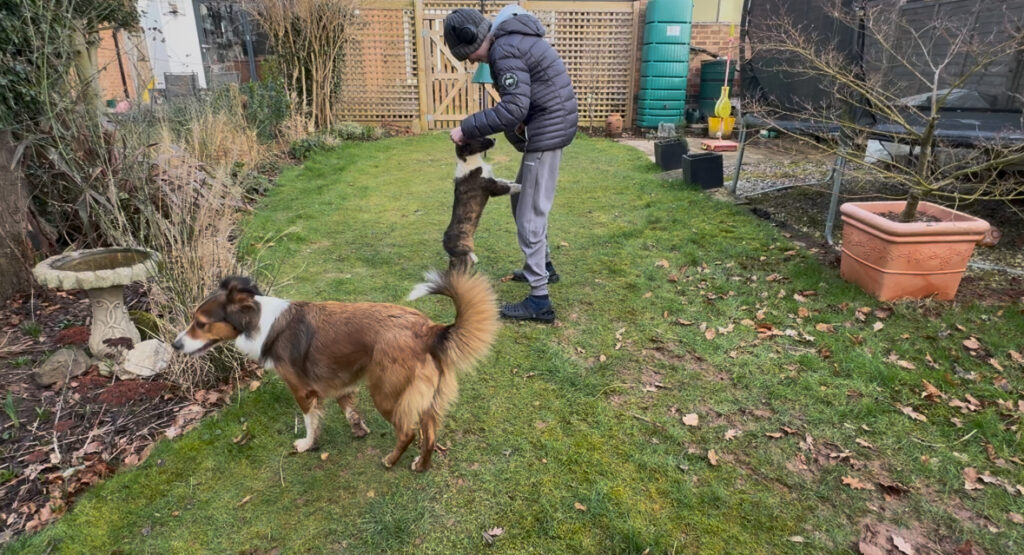
Impulse control is one of the most valuable skills you can teach your dog. Whether it’s resisting the urge to chase a squirrel, jump up on guests, or snatch food from the counter, self-restraint is the key to a well-mannered and adaptable companion. Many behavioural struggles stem from a lack of impulse control, but the good news is that any dog can improve with the right training.
Think of impulse control as teaching your dog how to press the ‘pause’ button instead of reacting straight away. With consistency, patience, and the right training techniques, you’ll see massive improvements in your dog’s ability to make better choices. In this guide, I’ll walk you through why impulse control is so important and give you practical, real-world training exercises that will help your dog develop this essential skill.
Why is Impulse Control Important?
Impulse control isn’t just about making your life easier—it makes life better for your dog too. A dog that can think before acting is calmer, more focused, and far less likely to get themselves into trouble. Whether you’re dealing with an excitable puppy, a high-drive working dog, or a dog who’s simply learned bad habits, impulse control training will help them cope with everyday challenges and build self-regulation.
Common situations where impulse control is needed:
- Jumping up on people – Teaching dogs to sit politely instead of launching themselves at visitors.
- Grabbing food – Helping them learn that waiting gets them better rewards.
- Barging through doors – Encouraging patience rather than pushing ahead.
- Overexcited behaviour on walks – Teaching calmness when spotting other dogs, wildlife, or distractions.
How to Teach Impulse Control
- Reward the Calm Choices Dogs repeat behaviours that get them rewards. If your dog sits instead of jumping up, that deserves praise! If they wait for permission before eating or going through a door, reward that self-restraint. Catching and rewarding good choices helps shape their behaviour in the right direction.
- Use Clicker Training A clicker is a fantastic way to mark the exact moment your dog makes the right decision. Click when they pause, hesitate, or show self-control, and follow up with a treat. This builds a strong association that calm behaviour = good things happen.
- Be Consistent Dogs don’t generalise well, so training needs to be consistent across all situations. If you let them jump up sometimes but not others, they’ll get confused. Make sure everyone in the household follows the same rules and expectations.
Practical Impulse Control Exercises
1. ‘Leave It’ Command
- Start by holding a treat in your closed hand.
- Say “leave it” and wait for your dog to stop trying to snatch it.
- The moment they back off, reward them with a different treat.
- Progress to placing the treat on the floor and covering it with your hand if they go for it.
- Eventually, move to real-life situations, such as leaving food on counters or ignoring dropped items.
2. Waiting for Food
- Ask your dog to sit before placing their food bowl down.
- If they move before you give the release cue, lift the bowl and try again.
- Only allow them to eat when they remain seated and calm.
- Over time, increase the wait time before giving the release cue.
3. Doorway Manners
- Before opening a door, ask your dog to sit and wait.
- If they try to barge forward, close the door and reset.
- Only allow them through when they wait patiently for your cue.
- This prevents door-dashing and encourages polite behaviour.
4. Calm Leash Walking
- Stop every time your dog pulls ahead and only move forward when the lead is loose.
- Reward them when they walk nicely by your side.
- Gradually introduce distractions to reinforce good behaviour in different environments.
5. Boundary/Bed Games
- Teach your dog to go to a designated bed or mat and remain there until released.
- Start by luring them onto the bed with a treat and rewarding them for staying put.
- Gradually increase the duration before releasing them.
- Use this game to manage excitement when visitors arrive or during meal prep.
- Introduce a release word and only reward your dog when they leave the bed on your cue.
- If they self-release, calmly guide them back and reset.
- Reinforce the behaviour by practicing in different environments with increasing distractions.
Making Impulse Control a Part of Everyday Life
Impulse control isn’t just about training sessions—it’s about reinforcing good habits in daily life. Here are some ways you can help your dog practice self-control naturally:
- Before getting in/out of the car – Ask for a sit and wait.
- During playtime – Encourage them to wait before chasing a toy or tugging.
- When meeting people – Reward calmness instead of jumping.
- Around distractions – Help them learn to check in with you before reacting.
By weaving impulse control training into your everyday interactions, it becomes second nature for both you and your dog.
Conclusion
Impulse control is one of the most valuable skills your dog can develop, and it will make life easier and more enjoyable for both of you. Whether it’s waiting for food, staying calm at the door, or walking politely on a lead, these training techniques will help your dog make better choices.
If you need personalised support to tackle impulse control struggles, Fresh Start Dog Training offers 1-1 training packages tailored to you and your dog’s needs. Get in touch today and let’s work together to help your dog master self-control and become the well-mannered, adaptable companion you want them to be!
Leave a Reply